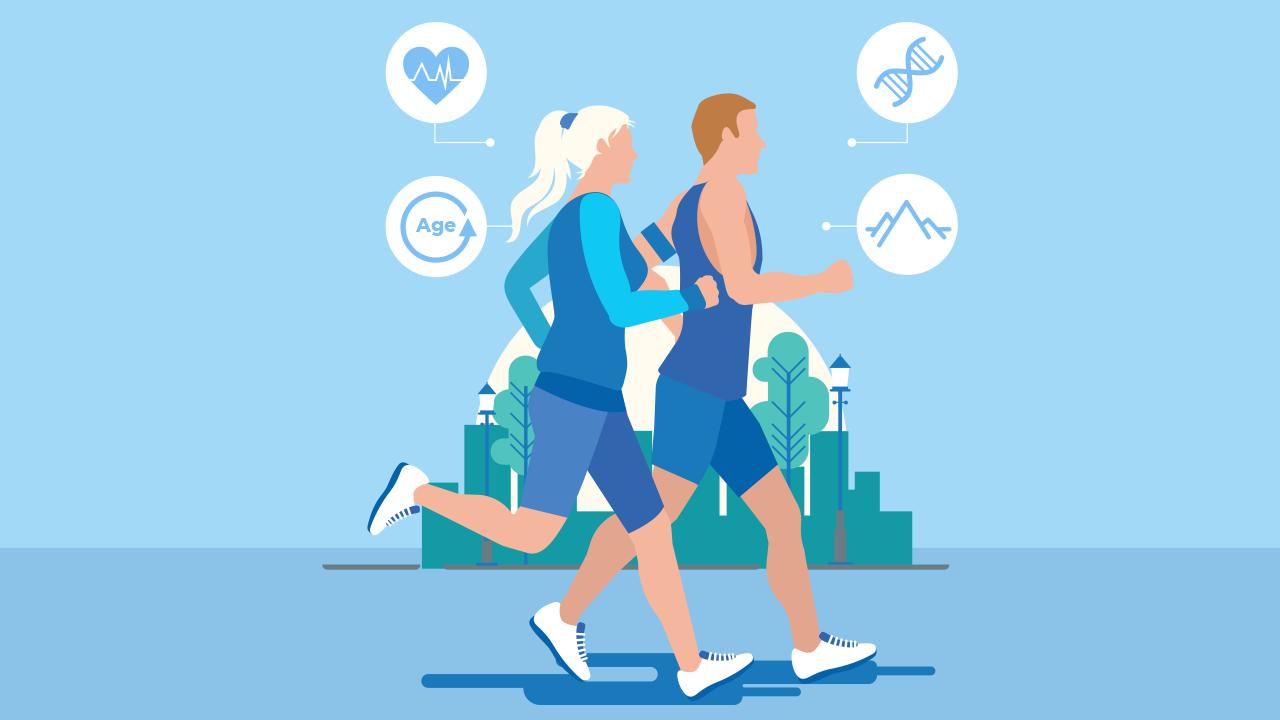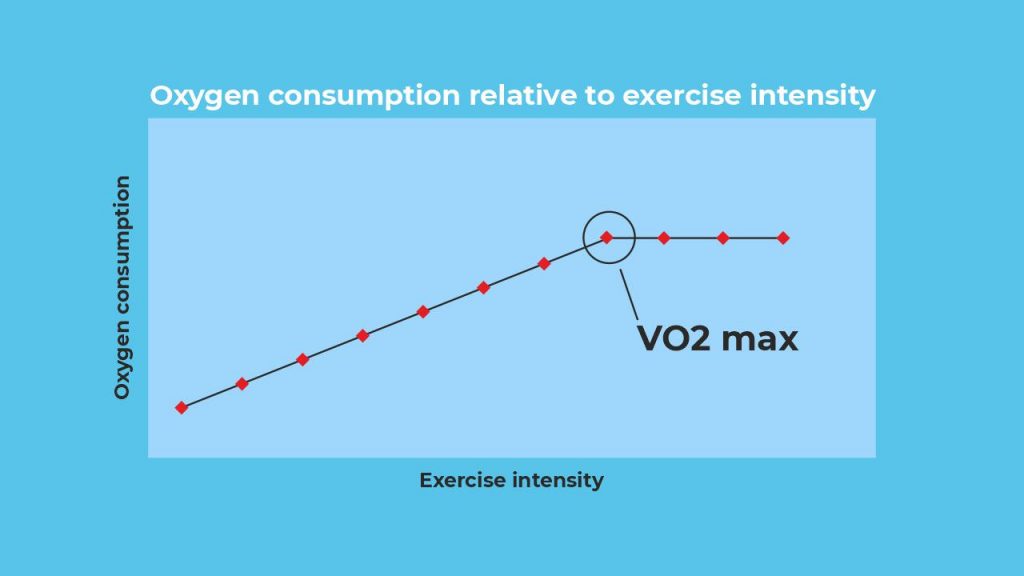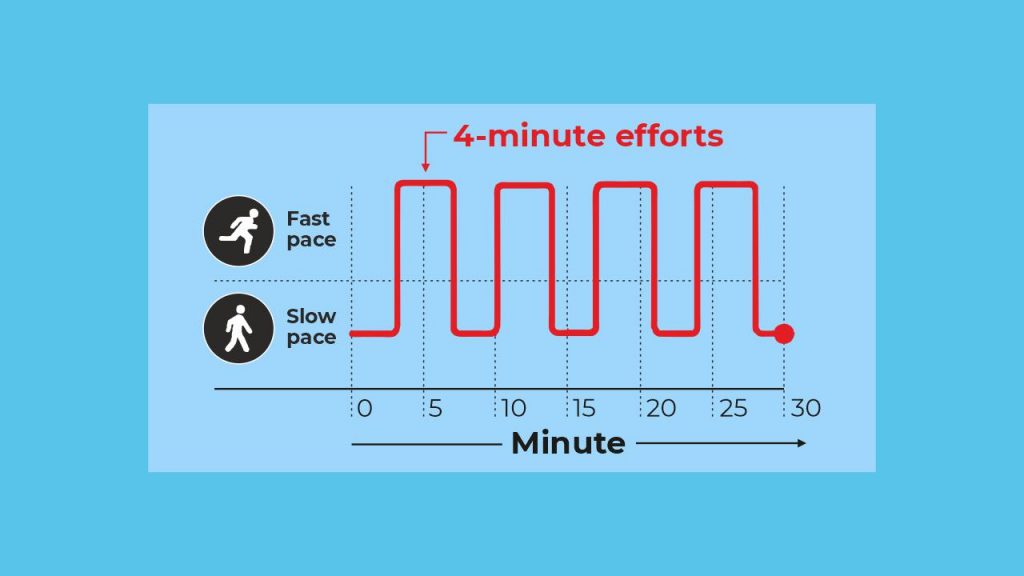
VO2max: Its Role in Running and How to Improve It

What makes some run faster than others? What distinguishes elite runners from recreational runners? The answer might lie in the concept of VO2max.
What is VO2max?
We breathe in oxygen from the ambient air, which then comes in contact with blood in the fine capillaries in the lungs. Our blood contains red blood cells, which reach the lungs from various parts of the body. These red blood cells have only bound carbon dioxide that is a result of burning an energy source such as carbohydrate. The red blood cells release their carbon dioxide and this in turn, is exhaled out of the lungs when we breathe out. Meanwhile, the oxygen from the air binds to the red blood cells. It is then transported to the tissues all over the body.

When we exercise, there is increased metabolic activity and the blood vessels dilate and allow more oxygen and nutrients to be taken up by the working muscles. As the intensity of exercise increases, there is a corresponding increase in oxygen uptake by the muscle cells. This oxygen combines with a fuel source such as carbohydrate or fat, and is used up to produce energy in “power houses” called mitochondria. The result of a series of reactions is the release of carbon dioxide, which is then carried back to the lungs and the cycle is complete.
When the intensity of exercise is maximum, the amount of oxygen that is consumed by the working muscles under aerobic conditions also reaches its maximum capacity. This is called maximum oxygen uptake or VO2max. It is measured in ml of oxygen per Kg of body weight per minute
VO2max is measured by making an athlete run on a treadmill. The athlete is progressively made to work harder and consumes oxygen as a function of exercise intensity that is measured using a mask that collects the oxygen and delivers it via tubes to an apparatus.
When we plot the graph of oxygen consumption during the above described test, the result will be as shown below, where the maximum oxygen consumed is clearly shown.

Why is VO2max important and how does it determine running capacity?
When we see the above relationship between oxygen consumed and exercise intensity, it would naturally mean that higher oxygen consumption will imply a higher capacity for intensity or speed. This, in turn, will mean that a runner with a higher VO2max, as determined by the above test, will have a higher endurance capacity and also produce a faster speed.
Broadly, this relationship is true and can be used to separate runners with different abilities for endurance. An indicative (meaning it may not determine race times for any unique athlete) running VO2max chart versus race times for different distances is given below for better emphasizing the point.
| VO2max | 1500m | 5 Km | 10 Km | 21 Km | 42 Km |
|---|---|---|---|---|---|
| 90.5 | 3:12 | 12:00 | 24:57 | 54:50 | 1:54:53 |
| 82.4 | 3:28 | 13:00 | 27:01 | 59:25 | 2:04:31 |
| 75.5 | 3:44 | 14:00 | 29:04 | 1:04:02 | 2:14:09 |
| 69.7 | 4:01 | 15:00 | 31:08 | 1:08:40 | 2:23:47 |
| 64.6 | 4:17 | 16:00 | 33:12 | 1:13:19 | 2:33:25 |
| 60.2 | 4:34 | 17:00 | 35:17 | 1:17:58 | 2:43:01 |
| 56.3 | 4:51 | 18:00 | 37:21 | 1:22:38 | 2:52:34 |
| 52.8 | 5:08 | 19:00 | 39:26 | 1:27:19 | 3:02:06 |
| 49.7 | 5:25 | 20:00 | 41:31 | 1:31:59 | 3:11:35 |
| 47.0 | 5:42 | 21:00 | 43:36 | 1:36:36 | 3:21:00 |
| 44.5 | 5:59 | 22:00 | 45:41 | 1:41:18 | 3:30:23 |
| 42.2 | 6:16 | 23:00 | 47:46 | 1:45:57 | 3:39:42 |
| 40.1 | 6:33 | 24:00 | 49:51 | 1:50:34 | 3:48:57 |
| 38.3 | 6:51 | 25:00 | 51:56 | 1:55:11 | 3:58:08 |
| 36.5 | 7:08 | 26:00 | 54:00 | 1:59:46 | 4:07:16 |
| 35.0 | 7:25 | 27:00 | 56:04 | 2:04:20 | 4:16:19 |
| 33.5 | 7:42 | 28:00 | 58:08 | 2:08:53 | 4:25:19 |
| 32.2 | 7:59 | 29:00 | 1:00:12 | 2:13:24 | 4:34:14 |
| 30.9 | 8:16 | 30:00 | 1:02:15 | 2:17:53 | 4:43:06 |
How can you train to improve your VO2max?
If you are looking for ways on how to increase your VO2 max while running, you need to train in a way to lift your entire aerobic base. This means that you have to work on different aspects of your training; right from putting in effort levels (60% – 75% of heart rate max.) that burn more fat in relation to carbohydrate, to using higher intensities (80% – 100% of heart rate max.) that emphasize more use of carbohydrates.
In order to cover the above spectrum of intensities, you may undertake three different types of training:
1. Building weekly mileage
It is important to do easy runs at comfortable intensity and log many hours of running on a weekly basis. These runs bring about adaptations such as fat metabolism, increasing the density of capillaries in the muscles and enhancing enzymatic activity,
2. Training your lactate threshold
This type of training helps the body to clear blood lactate (a compound that is secreted in the blood when intensity is high and which makes the blood more acidic) and is great for improving speed as well as endurance. The intensity at which this happens corresponds to a heart rate between 88% – 92% of max HR. Training the lactate threshold involves running at this intensity 10–20 minutes with rest periods in between and repeating such intervals.
Also read: Heart Rate Training: Role and Importance
3. Interval training
This type of running directly stresses the VO2max itself. Hence, the effort level is between 98% – 100% of max HR. Training involves doing short intense intervals for between 2–5 minutes with rest periods in between. This type of training is hard training and is stressful to the system of the athlete. A visual representation of such type of training is shown below.

What are the factors that determine your VO2max?
1. Age
With advancing age there is a progressive decrease in contractility, efficiency and fatigue resistance of the heart as well as skeletal muscles. You also lose muscle mass as you age and this constrains your ability to produce force.
2. Gender
Women have lower VO2max values as compared to men because of higher body fat content, smaller muscle mass as well as lower capacity for power generation in the muscles.
3. Change in altitude
As you go higher in altitude, there is a decrease in barometric pressure and oxygen content in the air. This in turn, means you breathe in less oxygen and hence it causes the VO2max to drop.
4. Fitness and training
VO2max is unique to each individual and based on your genetic background. Average athletes may have a VO2max between 35 and 45. It is possible to increase your VO2max but not by much. Healthy people, who train with a structured training program, may be ale to improve their VO2max at any age. The increase in VO2max is approximately 10%–15% from the base or initial value of a reasonably trained athlete. This percentage increase happens irrespective of the age at which you start training.
How do you measure or calculate your VO2max?
The gold standard for measuring VO2max is to have the athlete run on a treadmill starting at a comfortable pace and then increasing the pace in steps until the athlete can no longer carry one. Meanwhile, measurements are taken of heart rate and oxygen inhaled and carbon dioxide exhaled by using a face mask. This is a time consuming and expensive test that has to be done in a laboratory under supervision of trained test administrators.
The alternative is to do submaximal tests, ie, where the athlete does not have to push the heart rate to a maximum. There are many VO2max formulae. Some of these include:
1. Vo2max from resting and maximum heart rate
Measure your resting heart rate (RHR) by checking your pulse on the wrist. Easiest way is to measure your pulse for 20 seconds and multiply it by 3. For instance, if you get a count of 25 heartbeats, you resting heart rate will be calculated
RHR= 25×3= 75 beats per minute(BPM)
After this, you can calculate your maximum heart rate (MHR) by using one of two formulae:
For your maximum heart rate or Max HR, subtract your age from 220. Let’s assume the age to be 40.
Max HR= 220- 40 = 180
Your VO2max is estimated as = 15.3 x (MHR / RHR)
The above example would give you the VO2max as
VO2Max= 15.3 x (180/75) = 36.72 ml/kg/min
2. Cooper 12-minute test
Warm up with a brisk walk for 10 mins. Now use a course that is a loop (you could use an athletic track 400m loop) or use a treadmill. Start your stopwatch and jog / run at your best effort level, such that on completing 12 minutes of running, you are completely exhausted and your heart rate is near maximum. Measure the distance covered.
VO2max = (22.35 x kilometers) – 11.29
If you covered a distance of 2km, then
VO2max = (22.35 x 2) – 11.29 = 33.41 ml/kg/min
Out of the above two tests, the Cooper test is a much more accurate one with a 10% variation. However, if the formula was modified to VO2max = (21.09 x kilometers) – 11.04, the error is less than 5%, as can be seen from a study done on athletes in 2015.
There are now wearable GPS watches that are configured to calculate VO2max using various empirical formulae. These measure your heart rate, distance covered, and pace to use in these formulae that are proprietary to the manufacturer. In general, the VO2max values given by these watches have errors that vary from under estimating VO2max by 7% to overestimating by 10%.
VO2max is a good measure of your aerobic fitness levels and can help you define how you are placed vis-à-vis other runners or what kind of potential you possess as an endurance athlete. You can use it to measure your progress as you train over the years and to improve your performance.














